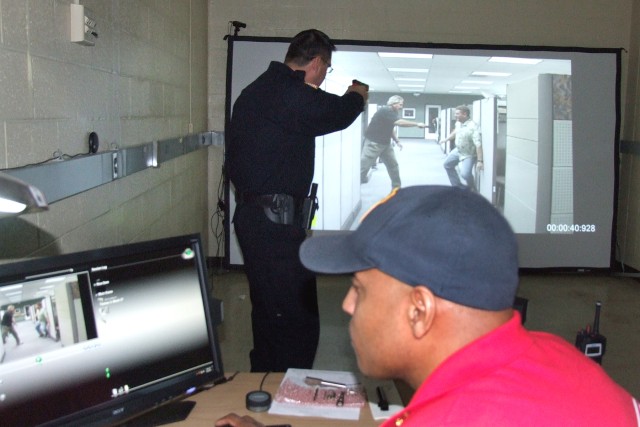
So you think you\'re good at Wii Sports' Think you can tear up the floor with Dance Dance Revolution' Think you can jam like Van Halen on Guitar Hero' Think again - because the Adelphi Laboratory Center has a new game in town that's more realistic, more useful and more fun.
The MILO Range Advanced System is an interactive training tool now being used by the ALC Police Department to maintain firearm proficiency and improve critical law enforcement tactics.
MILO consists of a laptop computer, high-definition projector and a large screen with hundreds of scenario possibilities including target practice, active-shooter, traffic stops, domestic disputes, workplace violence and more. But it's the system features that make the scenarios realistic -- things like:
* Hit detection and resulting scenario adjustments
* Carbon dioxide cartridges to simulate weapon recoil
* Various game weapons such as handguns, long guns, Tasers, batons and (OC) cannisters (i.e. pepper spray)
* An adjustable line-of-fire gun that shoots actual pellets at trainees to simulate bullets
"The MILO can help keep our police officers and security guards proficient in between scheduled visits to the actual firing ranges out at Blossom Point." said ALC Chief of Police Charles Roberson. "It also allows us to get our new employees initially qualified." And although MILO won't ever completely take the place of real range training, every officer and guard must qualify on the MILO system as part of the ALC Police Department's continuing, mandated in-service training.
It will also allow for year-round training in various real-world scenarios that actual firing ranges can't offer - things like the ability to change or adapt the scenario on the fly depending on how the trainee responds. For example, in a traffic stop scenario, the MILO trainer can adjust the module to reflect a compliant driver who responds to an officer's request, a belligerent driver who may pose a risk or a driver who hauls out a handgun. The trainee must then determine the appropriate use of force to resolve the situation. If the scenario calls for responding with deadly force, the actors in the video respond accordingly. If an officer's shot is within the "lethal" zone on the attacker's body (a zone which can be adjusted by the trainer), the actor may drop dead; but if the shot catches the actor outside the zone (such as a hand or leg shot), he or she could continue to be a threat.
The scenarios are replete with other interactive characters who could be victims, innocent bystanders, or accomplices. It's the trainee's job to sort it out and respond accordingly.
"The system videotapes the entire training session to assist with debriefings," said Sgt. Joe Pergerson, ALC Police Department Training Coordinator. "After each session, I discuss the scenario with the trainee, and then we review the tape together to see what really happened."
"The debriefing after the scenario teaches us how to articulate our actions and describe why," said Lt. Juan Ortiz following a training session. "This can be especially helpful in training officers and guards to explain their actions to command officials during real world use-of-force events."
Approximately 80 percent of the ALC police and guard force have qualified on the system since it was installed in December, and many of them have also been trained on specific scenarios. The $65,000 system is projected to pay for itself in 2-3 years by decreasing the number of out-of-cycle range visits.
The system can accommodate multiple trainees at once, which allows pairs or groups of officers and/or guards to practice communication and teamwork skills. An additional feature allows the organization to actually create their own scenarios using local facilities and terrain. Chief Roberson has plans to do that in the future so his staff can train on scenarios that are realistic to ALC.
"Eventually we may have scenarios for the Building 205 lobby or the front gate or other areas," Roberson said. "That would make the MILO system an even more valuable training tool."

Social Sharing